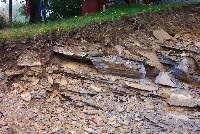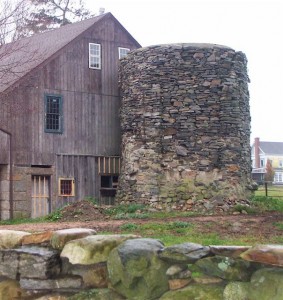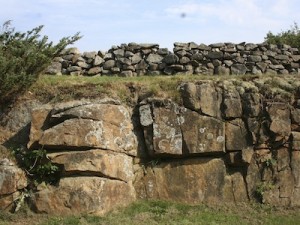
There are six hierarchical ranks within the this provisional stone taxonomy. The most inclusive rank, “bulk historic material culture,” is informally defined only so that the “stone domain,” the next-most inclusive rank, can be isolated from it. Below the level of the stone domain, each of these taxonomic ranks –class, family, type, subtype, and variant– are explicitly defined and are analogous to the groupings of the Linnaean taxonomy for life forms. At the most specific level of classification, the variability is too great to specify a taxonomic rank. Instead, we recommend using a consistent set of descriptors (modifying labels) equivalent to the “Var” (variety) name in the Linnaean taxonomy.
There is one universe of bulk material culture.
BULK HISTORIC MATERIAL CULTURE

The totality of bulk outdoor material culture is embedded within the functional, agro-ecological landscape. It’s five domains exclude the details of smaller, typically manufactured goods, more often found indoors. Its five domains are the:
- Wood of its barns, houses, sheds, barns, and vehicles; the
- Earth of its roadbeds, gardens, chimneys, meaning the granular residues such as gravel, sand, and clay, and lime; the
- Stone separated from Earth, the
- Fiber of its rope, leather, cloth, etc., and the
- Metal of its girders, stakes, hinges, braces, and farm equipment.
The idea is to create a parallel universe of material culture that is separate from the universe of objects that have already been extensively studied by historic archaeology: for example the objects of domestic life such as ceramic plates, tobacco pipes, silver spoons, bedding quilts, chamber pots, musketballs, and so forth.
DOMAIN
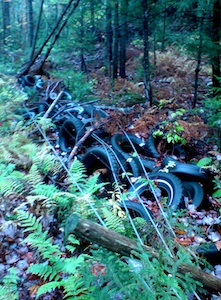
Having isolated a separate “outdoor” material culture, the next step is to isolate the the component built of stone from the other components, for example the wood, earth, fiber, and metal described above. To this component, I give the name “stone domain.” Specifically, it includes all groupings of stones, most commonly stone walls and stone piles, and individual stones that set apart from others, perhaps due to their size, shape, and position. most commonly they are carved stones, standing stones and glacial erratics. The stone domain specifically excludes ledge and bedrock outcrops, and undifferentiated stone within the soil. A domain is analogous to phylum in the traditional Linnaean taxomony.
Stone Domain, that part of bulk material culture composed of stone, natural or synthetic. There are five domains.
Class, the highest grouping within the domain stone. There are four.
Family, the highest grouping within the class wall. There are five
Types, the highest grouping within each family within the class walls.
Subtypes, the highest grouping within each type within each family within the class walls. Not all types have subtypes.
Variant, named variants of subtypes within types within families within the class walls.
Descriptors (Informal), describing in sequence the: condition of preservation, order of stone placement, characteristic shape and size, source of the stones, and architectural structure. For example, the wall I see most often, just east of my former house, is a heavily collapsed (condition), crudely stacked (order), slabby (shape), fieldstone (source), double wall (structure).
There are four classes in the Stone Domain.
CLASS
Features like this stone silo in Stonington, CT force an arbitrary distinction between the class “stone wall” and the class “stone concentration” within the stone domain.The Class Walls are typified by the classic New England fieldstone wall, and related foundation and mill-dam walls. They meet the three fundamental criteria of elongation, continuity, and elevation. The Class Lines are typified by the spaced lines of boulders protecting yards from vehicle traffic, as well as the low stones along borders of gardens. Rows satisfy the criterion of elongation, but fail either the criterion of continuity (by having gaps) or the criterion of elevation (by being too low). The Class Concentrations are a broad group that includes piles and monuments and patios. Usually they are differentiated from walls because they aren’t elongate enough. Finally, The Class Notable Stones is typified by the isolated boulders or quarried slabs so frequently adorning new construction. Gravestones and grinding stones also qualify as notable stones, provided they are considered individually.
Each class is subdivided into families that are distinguished by features that can be observed in the field, but which are named more generically based on their purpose or relationship to the soil.
There are five families within the class walls.
FAMILY
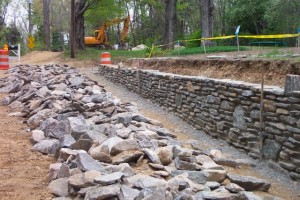
The Family Freestanding Walls stand above the ground surface (grade) on both sides, or nearly so. Here, the focus is principally the segment rather than the enclosure. A classic fieldstone wall is a familiar example. The Family Flanking Walls have either only one face or one face much higher than the other. They are typically embedded into the slope, stabilizing the terrain by physically supporting the soil on the upslope end (retaining walls), and (or) by protecting it from erosion. The Family Blocking Walls are built to hold back water, rather than soil. The stonework of the mill dam in the vicinity of a classic mill village provides the most familiar example. The Family Supporting Walls are built to hold up structures, usually wooden buildings such as houses, barns, and sheds. Many serve a subsidiary purpose as retaining walls. The Family Enclosing Walls are small enclosures in which the focus is on the enclosed space, rather than the segment. The town pound is a familiar example Normally, such walls are un-roofed, though they need not be. Stone chambers and New England’s rare stone houses fall into this category as well.
There are two families within the Class Line.
A Low Line is a continuous (not spaced) line of abutting stones too low to be considered a wall. Typically they are cobbles or small boulders used as a border. A High Line is a line of stones that are not abutting. Typically, these are high enough to qualify as a wall, but fail to meet its criterion of being continuous.
There are two families within the class Concentration. They are either built or dumped. Dumped concentrations are very common, being the type pile. Built concentrations are either the type Surface or the type Upright.
There are two families within the class Notable Stones.
Outsized notable stones are notable due to their large size, whether erratics or placed stones. Modified notable stones bear tool marks or cut surfaces or plaques or inscriptions of some sort.
TYPE
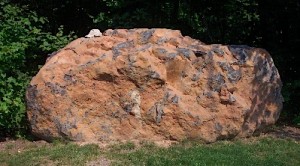
See descriptions of families.
SUBTYPE
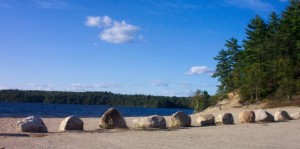
See descriptions of types.
DESCRIPTORS
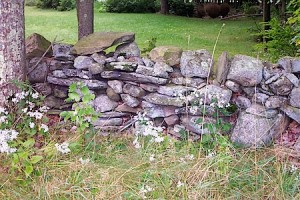
There is always a need to describe individual objects at a higher resolution than the taxonomic rank allows. Consider the case of the classic uncapped double wall found gracing long-established farmsteads throughout New England. This is normal subtype within a type (double), within the family (freestanding), within a class (wall). It could be mortared, or un-mortared, built of fieldstone or quarrystone. Additionally, it might be:
- Condition: Intact, partially collapsed, collapsed, etc, in decreasing preservation.
- Degree of Order: Patterned, laid, stacked, or dumped, in decreasing order.
- Stone Shape & Size: For example, slabby, blocky, bouldery, cobbly, etc.
- Stone source: Quarried, culled, or unculled fieldstone.
- Structure: Double or single, one-tiered or X-tiered, capped or uncapped, etc.
- Function: Foundation, retaining, or pen, etc.
